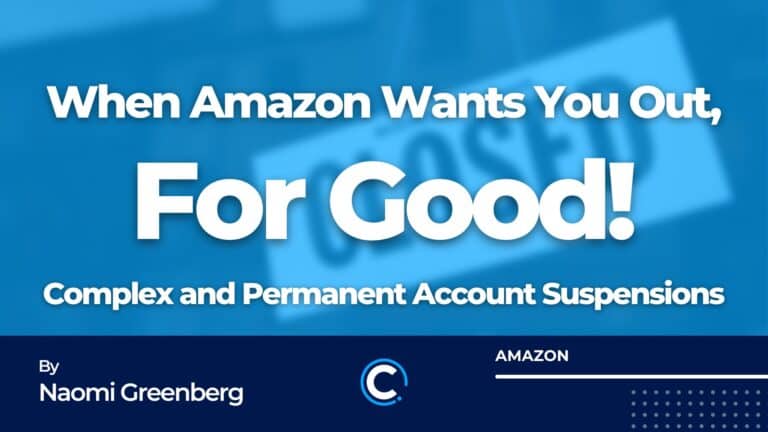
Amazon seller account deactivated? – How to deal with complex and permanent account suspensions
As a seller on Amazon, you are probably aware that if you violate the company’s policies, your account may be suspended. While there are various types of suspensions, some are more difficult to recover from than others.
In this article, we will discuss the most challenging suspensions – those where Amazon would rather you not return to the platform. These are the suspensions that you want to avoid at all costs!

Types of seller account suspensions on Amazon:
There are three categories of account suspensions on Amazon: easy, moderate, and difficult to permanent.
The severity of the suspension depends on the nature of the offense and the likelihood of it being repeated.
Here is a breakdown of what each type of suspension means for your account:
- Easy: These types of suspensions are often the result of a mistake or oversight on the seller’s part, such as delivering a product late (if you are an FBM seller) or selling products that appear to be damaged or used. These suspensions are typically easier to resolve and the account can be reinstated fairly quickly, as long as you address the issues.
- Moderate: A moderate suspension can occur in the case of a verification issue, safety or compliance issues, review manipulation (for the first time!) intellectual property violations, and more. These issues are complex, and may require a strong and well-documented appeal, but if you can provide evidence that you have resolved the issues, your account may eventually be reinstated.
- Difficult to permanent: The most challenging account suspensions are typically the result of severe violations of Amazon’s policies, such as selling counterfeit or inauthentic goods, or a violation of a certain rule like patent infringement for the SECOND time. It often occurs when the violation is clearly illegal, even outside of Amazon. In order to reinstate the account, it may be necessary to escalate the issue to higher levels within Amazon, or seek legal recourse. These types of suspensions are the most severe and should be avoided at all costs.
Although the specifics may vary, some of the most common and difficult-to-resolve suspensions include:
Types of permanent Amazon seller account suspensions:
Review manipulation suspensions for the second or third time:
Amazon prohibits any kind of review manipulation by its sellers, according to its policies. If a seller is caught engaging in review manipulation, such as offering free products or paying customers to leave positive reviews on their listings, they may be suspended from the platform. While it is possible to be reinstated after the first suspension for review manipulation, it is significantly harder, and sometimes impossible, to be reinstated after a second suspension. Therefore, if you are suspended a second time for review manipulation, you will need to provide an EXCEPTIONAL, OUTSTANDING and CONVINCING appeal in order to persuade Amazon that this was the last time you engaged in such behavior, and it will never happen again.
Manipulated documents:
Since Amazon requires very specific types and forms of documents, many sellers are tempted to “create” such documents on their own, and fabricate invoices/ other official documents, so that they could meet the strict requirements. Understandably, Amazon views the manipulation of documents, including the creation of fake invoices, letters of authorization, and testing reports, as FRAUD and will not reinstate accounts that engage in illegal or illicit behavior. The manipulation of documents is prohibited by law, and Amazon does not want to be held responsible for sellers who break the law on their platform.

Purchased insider information:
In recent years, we’ve seen a trend of “Amazon Insiders” leaking inside information about a seller’s account, in exchange for payment. This information, which is not available to the seller and includes Amazon’s confidential notes on the seller’s Performance history, should NOT be revealed. Buying such reports is not only illegal, but it goes against the company’s philosophy: to be reinstated, sellers should be working hard to investigate and understand what caused the suspension, and only then- fix the issues. Buying this information is a serious violation.
Inauthentic without a proof of authenticity:
If you are suspended for offering inauthentic goods and are unable to provide valid invoices, Amazon may consider you to be selling counterfeit items, which is obviously illegal. Amazon wants to avoid being held responsible for allowing sellers to sell counterfeit products on its platform, so it may be hesitant to reinstate your account if it cannot be definitively proven that your goods are genuine.
Drop shipping:
Until recently, drop-shipping suspensions could be resolved by changing your supply and shipping procedure and proving the change to Amazon. However, Amazon has recently become stricter and less likely to reinstate accounts that abuse the drop shipping policy. This could be due to the fact, that drop-shipping products are often purchased from competing platforms, and customers receive packages bearing these platforms’ branding (“Walmart”, “Ebay” etc.)
Relisting products that were removed and unsuccessfully appealed:
Amazon does not tolerate attempts to bypass its policies and authority, such as relisting products that have been removed or selling them on another account. If Amazon believes that you do not respect its policies and judgment, it may be hesitant to reinstate your account without a professional and persuasive appeal.
What should you do When Struck with a Difficult / Permanent Account Suspension?
- Investigate: Determine what Amazon is accusing you of, and assess whether you are guilty or if Amazon is mistaken.
- Plan your battle: Consult with colleagues and experts and decide on the best course of action. If Amazon is mistaken, you may need to prepare a strong appeal explaining why and how they were wrong. If you are indeed “guilty”, you will need to prepare a detailed, thorough, and future-focused appeal that convincingly demonstrates that you have learned your lesson and will not repeat the offense.
- Appeal: When dealing with an Amazon account deactivated appeal, we’ve observed that those challenging suspensions are frequently rejected by the Seller Performance department. Agents at this level often lack the authorization to approve such appeals, especially when accounts have been deactivated for serious reasons.
Yet, even when faced with the response “we will not respond to further emails/appeals,” there are circumstances where this can be successfully addressed.
- Escalate: In some cases, escalation is required. If necessary, you can escalate your appeal to higher levels within Amazon, which includes professionals with the authority to reinstate accounts with a severe history. An example would be the famous “Bezos department”, and other relevant departments. Before you escalate to the “Supreme Court” of Amazon, make sure to follow the proper channels.
- Lawyer up: If the Escalation was rejected and you feel that the suspension is unjustified, you can have a professional attorney send a legal demand letter to the Amazon legal department. While these letters can take some time, they may be successful if your lawyer is skilled and your argument is sound.
- Arbitration: While Amazon’s Business Solution Agreement makes it difficult to actually take Amazon to court to solve a dispute, it allows you to start an Arbitration. Arbitration is faster than litigation at Court, and typically takes up to 3-6 months. It is handled by the American Arbitration Association, and many of the arbitrations are eventually settled.

Key to Amazon seller account survival: Strict compliance with amazon policies
While it may be tempting to take shortcuts or engage in questionable practices, the consequences can be severe and long-lasting. If you do find yourself in the unfortunate situation of having your account deactivated, it is important to carefully assess the situation and devise a plan to address the issue.
This may include preparing a strong and professional appeal, escalating the issue to higher levels within Amazon, or seeking legal recourse.
By following the proper channels and demonstrating your commitment to complying with Amazon’s policies, you may be able to successfully reinstate your account and continue selling on the platform.

